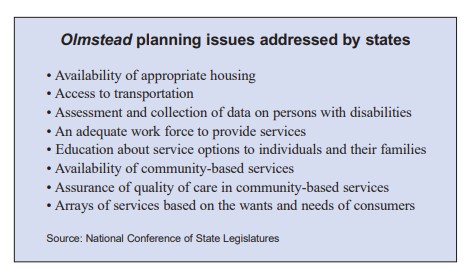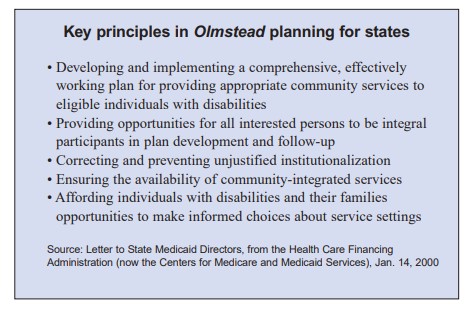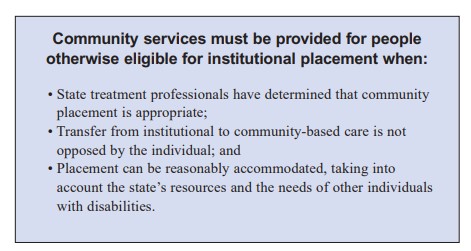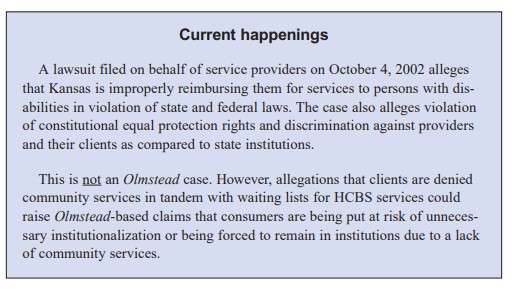The Centers for Medicare and Medicaid Services and OCR have issued guidelines to states for developing plans that can be used to demonstrate compliance. The principles included in this guidance, shown in the box on the facing page, serve as a foundation for OCR oversight and enforcement activities.
In February 2001, President Bush announced the New Freedom Initiative, a comprehensive plan to help people with disabilities integrate into communities. As a part of this initiative, HHS has initiated the “Systems Change Grants for Community Living” program. The Kansas Department of Social and Rehabilitation Services received a $1.4 million grant in 2002 to help design and implement improvements in community-based systems. A $725,000 grant to improve consumer-focused personal assistance services was awarded to the University of Kansas Center for Research.
Measuring Compliance
The Supreme Court’s decision was not intended to be an open-ended requirement for states to provide community-based services for everyone who requests them. States are required to make reasonable modifications to accommodate community placements but are not required to make fundamental alterations to the nature of their services or programs. The Court suggested that states can show compliance by demonstrating they have a comprehensive, effectively working plan for placing qualified persons with disabilities in less restrictive settings and a waiting list for community services that moves at a reasonable pace.
The Court recognized that states must maintain an array of services and facilities for a range of disabilities and that they have an obligation to administer services equitably across the entire population of people with disabilities. Unfortunately, the practical implication of key terms used by the Court to define the states’ obligations under the ADA is not clear. Subsequent court decisions will determine the full impact of the decision on state programs.
A March 2000 report from the Kaiser Commission on Medicaid and the Uninsured suggests four ways to measure compliance with the court decision, although the report proposed no benchmarks for achieving compliance.
-
- The proportion of people in institutions for whom an assessment of the appropriateness of community placement has not been completed.
- The length of a waiting list, compared to the need and the length of the wait.
- The number of people in the community who are determined to be receiving services appropriate to their needs.
- The proportion of people who need institutional services who are able to receive them there.
Reasonable Accommodation vs. Fundamental Alteration
The Supreme Court was clear that the needs of people with disabilities who are able to be placed in the community must be balanced against the needs of people who require institutional services. A state may be able to defend against an Olmstead suit by showing that moving individuals or group of individuals into a community setting would harmfully reduce services to other persons with disabilities who need institutional care.
Reviews of litigation suggest a few emerging principles courts will use to determine whether a requested program change alters the basic character or an essential feature of a program, a fundamental alteration, or modifies a more peripheral aspect, a reasonable accommodation. These principles are:
-
- The potential state cost of a program change requested by an individual or group will not, by itself, determine whether the change will be required. Courts will generally look at all available resources, the needs of other persons with disabilities and the state’s history in funding community services in making a judgement.
- Courts are likely to require that all federally approved slots in HCBS Medicaid waivers are funded but will not require the state to add slots to accommodate a request for services.
- Courts are not likely to order changes to eligibility criteria if they are determined to be an integral part of the character of a program. If exceptions have been made in the past, then courts are more likely to order modifications.
- Whether states are required to add new services to programs or expand programs that would facilitate community integration is not uniformly decided at this point. However, decisions imply that states must reasonably fund the services they currently provide.




